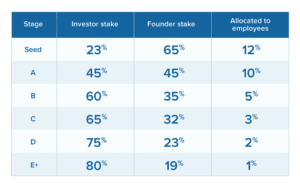
Understanding how to manage startup equity distribution successfully is one of the core pillars of ensuring your early-stage startup is set for success. It is common for founders to over-distribute equity, lack understanding of who gets how much of the pie, and over-promise shares in hopes of finding traction. This article will teach you how to manage your equity to keep your business on track for a promising future.
What Is Startup Equity
Let’s start with the basics. In a nutshell, startup equity is a term used to define the amount of company ownership that founders, investors, and employees are issued. Founders start with full ownership of their company. As startups grow and expand, founders exchange a portion of their company’s current or future value (equity) in exchange for their stakeholder’s commitment (capital, time, or expertise.)
The end result of this is a founder offering a chunk of the 100% ownership that they retain to core stakeholders who are supporting the company to reach success.
During the early-stage startup days, founders will often need to offer larger portions of their equity to account for the risk investors are taking by funding their enterprise. This number lessens once a track record of success is proven.
If a company has many owners, it’s important to decide how equity ownership is structured as you are starting the enterprise. For example, if your company has three owners, do all founders own an equal third? Be sure to have a clear equity ownership plan before beginning any talks about exchanges.
Even more important than this is remembering that once you give away more than 50% of your total equity, you are no longer a majority shareholder. Always be sure to covet your company equity and exchange it wisely.
Who Gets Startup Equity
There is no magic equation for deciding who does and does not get company equity. Overall, it’s important to keep your company’s ownership stake in the right hands. And when it comes to equity structuring, there are four key stakeholder groups that typically receive equity in a startup:
- Founders/Co-Founders
- Employees
- Investors
- Advisors
It is crucial to hold onto equity and distribute it wisely. This means finding a balance and avoiding the temptation of over-committing. Many first-time founders will make the mistake of offering too much equity to secure a relationship or investor, only to find out that the return just wasn’t there.
One method of understanding whether or not you are distributing your equity effectively is to assess allocation based on company maturity. The table below shows a benchmark for equity distribution by stakeholder group:
Not all startups will follow this graphic identically. No matter the approach, it’s important to create and follow a clear framework for how you distribute equity.
Startup attorney Matthew Rossetti notes that “Easily 60% of the time founders end up in court, it boils down to equity distribution issues.” Typically, arguments focus on the fairness of equity structures.
An easy solution for this is to split all equity shares equally. Another approach is to create a dynamic equity model that establishes a particular equity percentage based on employee tenure, investor pledges, and founder investments. As with any form of group work, those who have offered more expertise, time, or money than others should be valued in line with their contributions. This will ensure equity is distributed fairly and transparently within the startup, in order to foster trust and alignment among all stakeholders.
Giving Equity to Founders and Co-Founders
When you are working with one or more co-founders, you should begin speaking about equity early and openly. There are a few core pieces to consider when evaluating your equity stake, including:
- Time Invested
- Capital Invested
- Intellectual Property/Ideas
- Risk (financial, personal, etc.)
The value you assign to each of these variables should remain proportionate to the investment each founder has made. Common investor splits may look like 30/30/30, 60/40 or 70/30.
If you and your co-founders are unable or unwilling to determine the split on your own, you may decide to engage with advisors or your board of directors. This can help to make sure the equity is distributed among founders in an unbiased manner.
Issuing Equity to Advisors
Next to founders, assigning equity to advisors is the most challenging piece of the puzzle. And, unlike startup mentors who typically occupy a more informal role, startup advisors are usually compensated for their work. An advisor can save founders from costly mistakes, help them land new partnerships, or offer a listening ear. However, despite their clear value to founders, it can be tricky to assign equity stakes.
A good rule of thumb is to offer 0.2% to 1% equity to advisors. These shares are typically structured as advisory shares that are structured as common stock on a vesting schedule. This ensures that advisors stick around to shepherd their part of the work while the company grows.
Once your company matures, you can add more expectations around their role and increase their equity package should their role require it. Keep in mind that the total allocated for Employees and Consultants Shares Options Plan (ESOP) is generally around 5-10% with no more than 2% allocated to advisors.
Giving Equity to Investors
Founders may seek out investments from a number of different investors including family and friends, angel investors, venture capitalists, or strategic partners.
To determine the amount of equity an investor will see in return for their investment, consider the amount they are willing to invest in both time and money.
It’s common for equity asks to take place as the investment is negotiated. As a founder, it’s important to have a clear idea of the value of your company and the value of an investment. Angel and venture capital investors are great, but they must not take more shares than you’re willing to give up.
On average, founders offer 10-20% of their equity during a seed round. You should always avoid offering over 25% during this stage. As you progress beyond this stage, you will have less equity to offer. Therefore you should continue to offer less equity in each subsequent round.
It’s essential to negotiate with your investors when determining shares to offer. Prove your value, and be sure to assess each investor for more than just the capital they bring to the table. Will they help you secure a new client? Are they a strategic partner? Don’t forget your value once you get to the table.
Issuing Equity to Employees
Startups offer an exciting workplace for employees. Oftentimes employees are able to bring ideas to life in a way they’ve never experienced before. Despite this, it’s common to see startups that struggle to match market-rate salaries, especially for founders bootstrapping on a short budget.
A fix for frugality comes in the form of offering employees a stake in the company. By offering equity to early-stage employees, founders help engage workers and motivate them to work for their returns.
Additionally, offering stock provides the following benefits:
- Lands top talent
- Retains high performers
- Helps to develop an ownership mentality
- Aids in keeping cash in the bank
So how do you decide who gets equity? Much of this depends on the stage of the company.
According to The Muse “[a]t a typical venture-backed startup, the employee equity pool tends to fall somewhere between 10-20% of the total shares outstanding. The number of shares or options you own divided by the total shares outstanding is the percent of the company you own.”
For example, it is common at the early stages for top talent such as a senior engineer to retain as much as 1% of a company.
How you structure equity is important. Typically, employees are awarded shares in a Restricted Stock Unit (RSU) that requires the employee to achieve certain milestones – such as years of service – before the stock is earned. In the section below, we’ll define the other types of shares that you may consider offering employees.
To learn more about startup equity, see if you qualify for membership to join Founders Network.
Types of Startup Equity
Equity does not come in a one size fits all structure. There are several types of startup equity structures including Common Stock, Preferred Stock, Restricted Stock, Restricted Stock Units (RSUs), and types that include stock options or options pools.
In the graph below, the structure of these equity models is defined by key characteristics:
|
Type of Equity |
Voting |
Dividend |
Conversion Rights |
Liquidation Rights |
|
Common stock: Owners with voting rights |
Yes |
Yes, eligible but at the discretion of board members. |
Allowed to be converted into cash or other types of equity. |
No |
|
Preferred stock: Owners without voting rights |
No |
Yes, eligible based on fixed rate or preference. |
Allowed to be converted into stock or other types of equity. |
Preferred stockholders may have a preference to receive priority return on investment in advance of common stockholders. |
|
Restricted stock units (RSUs): Owners of a number of common or preferred stock once vested. |
Yes, if common stock. Can vary. |
Yes, if common stock. Can vary. |
May be eligible depending on the stock type and terms. |
May be eligible depending on the stock type and terms. |
|
Stock Options and Option Pools: Right to become owners of a number of common or preferred stock at a fixed price in the future, once vested. |
Yes, if common stock. Can vary. |
Yes, if common stock. Can vary. |
May be eligible depending on the stock type and terms. |
No |
The main differences in the types of equity options are the ability to control certain aspects of the company. For example, some models allow for different levels of ownership, voting rights, and flexible compensation for employees. Below we will dive into the differences more in detail.
Common stock
Common stock represents an ownership stake in a company. Once assets and liabilities are balanced, the remaining value represents all shares of stock. Owners of common stock are shareholders and have voting rights to elect members of a board or directors. Individuals who hold common stock receive the right to dividends and the right to the residual value of assets upon liquidation.
Preferred stock
Preferred stock is typically equity purchased by investors when financing a startup company. The main difference between preferred stock and common stock are as follows:
- Preferred stockholders have a preferential claim on the assets and earnings over common stock.
- Preferred equity does not come with voting rights
Startups use preferred equity, or stock, to raise capital while maintaining control over their company. This is because without voting rights these owners have less control over decisions made by the company.
Restricted stock units (RSUs)
Restricted Stock Units or RSUs are typically used to grant employees shares of a company. These shares are almost always based on a vesting schedule, which helps companies ensure ownership is earned once certain milestones are met. Vesting schedules are generally based on employee tenure.
RSUs are beneficial to founders and startups as they attract top talent, motivate employees, and help early-stage startups manage cash flow. Vesting schedules for startups vary widely. A typical structure for vesting is four years with a one-year starting point. At Amazon, 5% of employees’ shares vest after one year, 15% after two years, then 40% after the third and fourth years.
Options (including stock options and option pools)
Stock options are shares offered under an agreement to sell or buy a certain number of Common or Preferred Stocks at a future time for a fixed price, also known as grant price. It is common for startups and private companies to offer stock options or options pools as part of their company’s compensation package. This motivates employees to work hard, with the option of capitalizing on a stock at a later date before the offer expires.
The Role of Equity in Raising Capital for Your Startup
Fundraising is the critical ingredient for success at any startup. Whether a founder starts their fundraising through crowdfunding or through financing rounds, understanding the value of a company’s equity is essential. Managing equity well is a core factor for success. It defines a startup’s ownership structure and valuation. Companies raise money to start up, fund a growth project, and expand the success of their venture. By selling shares, whether publicly or privately, a business effectively sells ownership in its company in return for cash.
How To Manage Equity as Your Startup Grows
No matter where you are in your startup journey, managing your equity is an integral part of the founder’s journey. To ensure you are set up for a prosperous future, don’t forget to regularly review and update your equity structure as your company grows and evolves. The best plan of action is to get ahead of the common mistakes founders make. Here is a non-exhaustive list:
- Avoid dilution – As a founder, you must remember that the more equity you give away, the less of your company you own. Create a plan before you sell your first company share that defines how much equity you are willing to give up, and stick to it.
- Dead Equity – Be smart about the equity you offer and at what vesting schedule early on. If you are still growing, and will need equity for future growth, consider an eight-year vesting schedule to retain additional equity
- Regularly Review Your Cap Table – A cap table, or capitalization table, is a list of all those who have ownership in a company. If you review your ownership split regularly, you’ll avoid buy-backs and understand whether you have room to grow.
FAQs About Startup Equity
Still have a burning question about startup equity? Take a look at the FAQs below to get all the answers you need to grow your enterprise.
What is the process for calculating the value of my startup?
There are several ways to calculate the value of your startup. First, consider if you are pre- or post-operation. Second, take time to research companies of similar size and industry to begin benchmarking. From there, select one of these 4 methods to land the final number.
How can I address dilution of equity as I bring on new investors or grant additional equity to employees?
Dilution happens when a company issues additional stock, and the current shareholders’ ownership in the company is therefore reduced. The good news is, there are several strategies you can take to address debt dilution. To start, always visit your cap table to understand how various equity offers will dilute the stake of current shareholders. Second, be reasonable about your investors and the equity you can share. Yes, it may seem like more money is better, but you should not give up additional equity for cash you don’t need. Another tip is to review your vesting schedule and ensure it is on track with your company’s goals.
Remember, you can also use share buybacks to reduce the dilution caused by employee stock option plans.
What are the best practices for structuring equity incentives for my team?
The most common equity model used to compensate employees is Restricted Stock Units (RSUs). RSUs benefit employees and company owners by ensuring employees meet certain milestones before their money vests and converts into owner shares. This keeps employees working hard, and founders in control of cash flow and retention.
How do I implement vesting of equity for co-founders and employees?
Under a standard vesting schedule, stock vests in quarterly or monthly installments over four years. If a founder or employee leaves a company before the stock is fully vested, the company has a right to buy back unvested shares at fair market value. Learn more about vesting structures here.
What are the legal and tax considerations for issuing equity that I should be aware of?
According to smallbiztrends.com, “Raising capital by seeking new investors—family, friends, strangers, other businesses—does not present any immediate tax consequences. The cash and/or property is a contribution to the capital of the business.” Despite this, it is always best to talk with a CPA or legal expert to best understand your obligations.
How do I plan for the eventual sale or IPO of my company and the distribution of equity among shareholders?
The SEC outlines that, “Existing shareholders can sell their shares in the IPO if their shares are included in and registered as part of the offering. Most large IPOs include only new shares that the company sells in order to raise capital.”
How do I resolve conflicts or disputes over equity among co-founders or team members?
Even with the best intent in mind, conflicts with teams appear. Be sure to get all equity allocations written and agreed upon by all members. This will help you get ahead of any potential disputes about equity. As part of this, develop regular meetings to review your cap table and assess if any equity changes are necessary. If you can’t resolve the issue on your own, enlist a board of directors.
Ready to take your startup knowledge to the next level?
Understanding how to manage startup equity distribution successfully is one of the core pillars of ensuring your early-stage startup is set for success. In this article, we detailed the power of harnessing and managing your startup equity for success. Whether it be for landing new investors, or retaining top talent, equity is a powerful tool for developing shared ownership for your startup.
No matter the stage of your startup journey, connecting with like-minded founders and mentors for professional advice on equity matters is essential. This will help to make sure you are making informed decisions about the ownership and control of your company.
Take the plunge and join the Founders Network’s community to learn more about navigating equity and funding for your startup.







